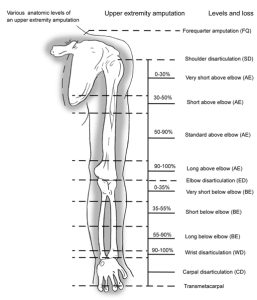Transhumeral Prosthesis
Functional Levels Above the Elbow
Amputations above the elbow may be classified in three basic functional levels. This system of classification is based on the anatomy that provides the primary control. Note: There is no standard classification system… it may depend on length of limb or based on the body function.
 I. Elbow Disarticulation: Typically, the remaining anatomy includes the humeral condyles.
I. Elbow Disarticulation: Typically, the remaining anatomy includes the humeral condyles.
- Primary control of the prosthesis is by the humerus.
- The humerus controls motions of flexion, extension, rotation and abduction, but are dependent on the fit of the socket
- The oval shape of the distal end can provide rotational control and stability of the prosthesis.
- The available ROM and lower placement of the base plate allows the individual to capture ample excursion to operate the prosthetic elbow and TD.
- For limbs 95-100% of arm length, a single wall socket is used.
II. Standard Transverse Humeral Limb Loss: The remaining anatomy is above the humeral condyles (long transhumeral).
- For limbs 50-90% of arm length.
- Primary control of the prosthesis is by the humerus assisted by the shoulder girdle.
- The humerus provides flexion, extension and abduction stability, but is dependent on the fit of the socket
- The shoulder girdle provides rotational stability
- The prosthesis is secured to the shoulder girdle providing an A-P compressive force between the deltopectoral groove posteriorly over the scapula.
- To achieve maximum operation of the components, use the available control motion measurements in the design of the socket and harnessing system.
III. Short humerus: The remaining anatomy is from the deltoid insertion to the axillary level (short transhumeral).
- Primary control of the prosthesis is by the shoulder girdle assisted by a short humerus.
- Prosthesis operation is dependent on bilateral shoulder girdles motions
- The trimlines limit shoulder movement in all three planes
- Pre-positioning of the prosthesis is limited.
- Shoulder girdle provides flexion, extension, abduction and rotational stability
- Prosthesis operation is dependent on bilateral shoulder girdles motions
Each wall of the prosthetic socket has a specific purpose
-
- Anterior wall
- Provides rotational and extension and protraction stability
- The deepest point of deltopectoral groove is about 2.5-5cm distal to clavicle and medial to head of humerus
- Flared at edges
- Posterior wall
- Provides rotational and flexion stability
- Posterior compression aligns with plane of scapula and is a counterforce to the anterior compression
- Medial – humerus and axilla
- Provides medial-lateral stability
- Provides stability when using the elbow lock cable
- Total contact between medial and lateral walls, gentle contact with tendons
- Lateral wall
- Provides abduction stability distally
- May provide location for attachment of lateral suspensor
- If sensitive, pressure relief at distal lateral
- Anterior wall
